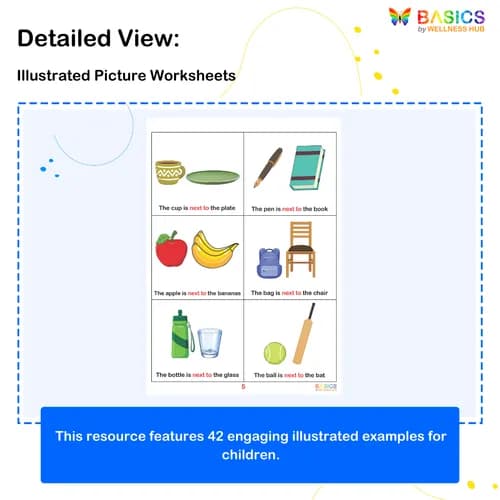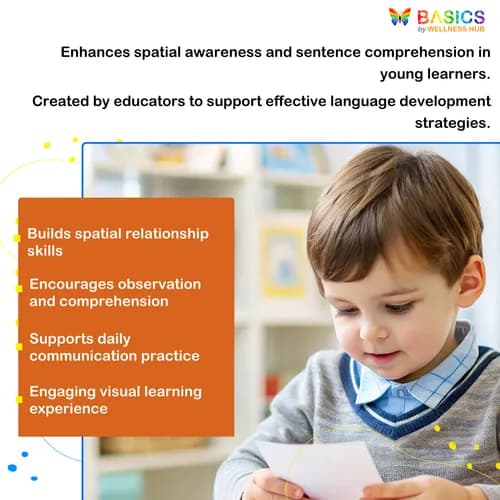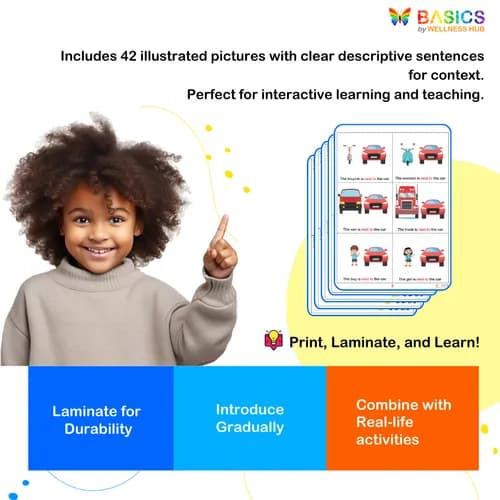





NEXT TO – Learn Object Position with “Next To”
₹80
₹160
50% off
0 (0 ratings)
Grade Levels
Pre-K - Grade 2 (Ages 3-7)
Content Overview
Format: Printable PDF, Total Pages: 7, Features: 42 illustrated pictures demonstrating the preposition 'next to'.
Categories
Pages from the Resource
Help children learn the preposition 'next to' with this engaging printable PDF. Featuring 42 illustrated pictures, each page includes 6 examples showing objects placed beside one another, along with clear descriptive sentences. This resource enhances spatial awareness, observation skills, and sentence comprehension for young learners.
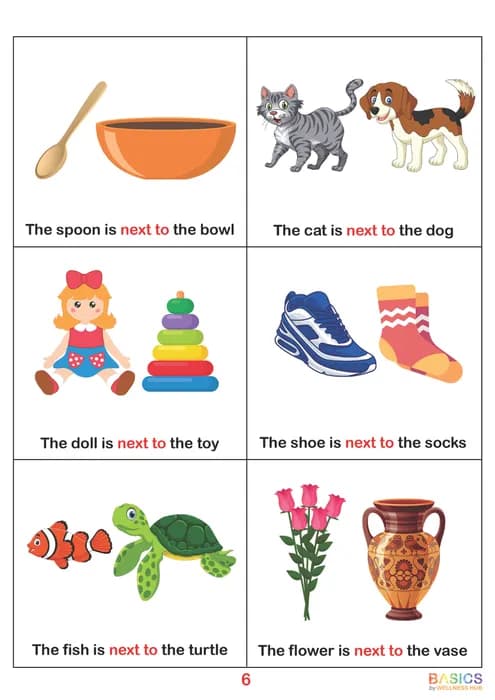
Page 1

Page 2
What Users Say
0
0 ratings
5
0+
4
0+
3
0+
2
0+
1
0+
5 Stars
Product is Good to use.
1 year ago
Varsha Parent
Similar Products
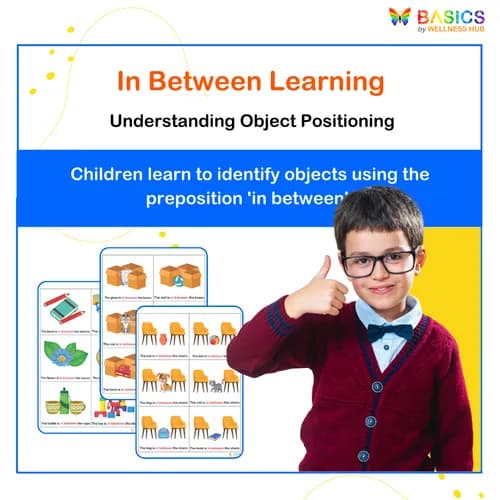
In Between – Learn Object Position with Illustrated Examples
₹ 80.00
₹ 160.00
50% off
4.9 (52 ratings)
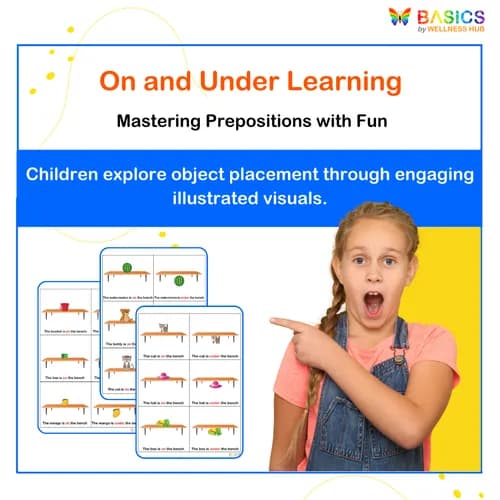
ON & UNDER: Basic Object Position – Printable PDF for Kids
₹ 80.00
₹ 160.00
50% off
4.8 (48 ratings)
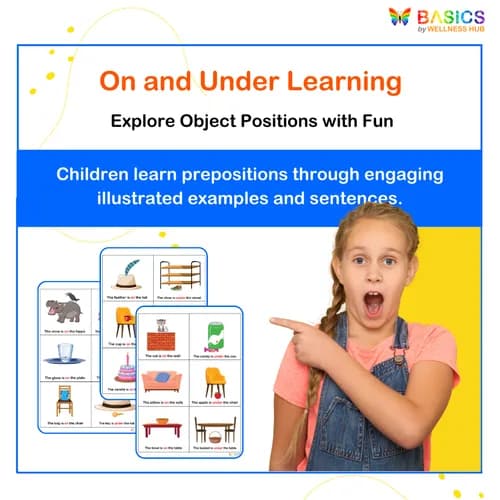
ON & UNDER: Mixed Object Sets – Prepositions Activity for Kids
₹ 80.00
₹ 160.00
50% off
4.9 (52 ratings)
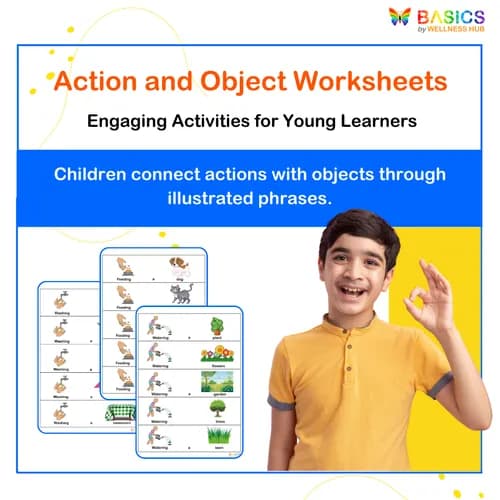
Action + Target Object Worksheet Set – Verb and Object Learning
₹ 80.00
₹ 160.00
50% off
5.0 (56 ratings)

CAUCASIAN BOY: Learn “My” with Everyday Objects – Printable PDF
₹ 80.00
₹ 160.00
50% off
4.9 (52 ratings)
About the Product
Introduction
Understanding prepositions is a fundamental aspect of language development for young learners. The NEXT TO – Printable Worksheets for Kids resource is designed to help children grasp the concept of spatial relationships through the preposition "next to." Aimed at children aged 4-8, this engaging PDF includes a total of 7 pages filled with colorful illustrations that depict various objects positioned beside one another. Each page features 6 illustrated pictures, providing a total of 42 visual examples that make learning fun and interactive.
By using simple sentences like "There is a kite next to a bird," children can enhance their comprehension and communication skills while practicing the use of positional language in everyday contexts. This resource is perfect for parents, teachers, and therapists looking to support language development in home, classroom, or therapy settings. With its clear visuals and straightforward structure, this printable worksheet is an effective tool for reinforcing spatial vocabulary and sentence formation.
Product Details
- Resource Name: NEXT TO – Learn Object Position with "Next To"
- Format: Printable PDF
- Total Pages: 7
- Illustrated Pictures: 42 (6 pictures per page)
- Content: Each picture shows two items positioned next to each other, accompanied by a descriptive sentence.
- Example Sentences: Includes sentences like "There is a kite next to a bird" and "There is a cup next to a plate."
- Designed For: Early childhood education, speech therapy, and language development activities.
- Best Suited For: Ages 4-8, Pre-K to Grade 2.
- Usage Notes: Ideal for individual practice, group activities, or as part of a language curriculum.
Educational Benefits
1. Enhances Spatial Awareness
- Helps children understand the concept of position and location through visual examples.
- Encourages them to recognize and describe the relationship between objects in their environment.
2. Improves Language and Vocabulary Skills
- Expands children's vocabulary by introducing and reinforcing the use of the preposition "next to."
- Supports sentence formation and comprehension through clear, descriptive examples.
3. Fosters Observation and Critical Thinking
- Encourages children to observe details in illustrations and think critically about object placement.
- Promotes discussion about different spatial relationships beyond just "next to."
4. Supports Early Literacy Development
- Builds foundational literacy skills by connecting visual images with written language.
- Encourages reading practice as children read sentences that describe the pictures.
5. Engages Multiple Learning Styles
- Appeals to visual learners through colorful illustrations and engaging content.
- Can be used in various settings, making it adaptable for different learning environments, including home and classroom.
Instructions for Use
Step 1: Print the Worksheets
- Download and print the 7-page PDF resource on standard A4 or Letter-sized paper.
- Consider laminating the pages for durability if using in a classroom or therapy setting.
Step 2: Introduce the Concept
- Begin by explaining the preposition "next to" using simple language.
- Show a few examples from the worksheets and read the sentences aloud to the child.
Step 3: Engage with the Illustrations
- Go through each page together, discussing the objects in each illustration.
- Ask the child to identify which items are next to each other and encourage them to describe the relationships.
Step 4: Practice Sentence Formation
- Encourage the child to create their own sentences using "next to" based on the illustrations.
- Prompt them with questions like, "What is next to the cat?" to reinforce understanding.
Step 5: Interactive Activities
- Use the worksheets for interactive games, such as matching objects or drawing their own examples of items next to each other.
- Encourage children to use toys or real objects around them to practice the concept in a hands-on way.
Step 6: Reinforce Learning
- Review the worksheets regularly to reinforce the concept of "next to."
- Encourage children to use the preposition in their daily conversations to strengthen retention.
Step 7: Adapt for Group Learning
- Use the worksheets in small group settings to promote collaborative learning.
- Encourage children to take turns reading sentences and discussing the illustrations together.
Activities Using the Resource
1. Picture Identification Game
Objective: Enhance recognition of spatial relationships using visual cues.
How to Play:
- Display a page from the worksheets.
- Ask the child to point out and name the items next to each other (e.g., "What is next to the cat?").
- Encourage them to read the sentence aloud for reinforcement.
Skill Development:
- Vocabulary expansion
- Visual recognition
- Sentence comprehension
2. Sentence Creation Challenge
Objective: Foster creative sentence formation using the preposition "next to."
How to Play:
- Choose an illustration and ask the child to create a new sentence using "next to" (e.g., "There is a ball next to a box.").
- Encourage them to use different objects or scenarios for variety.
Skill Development:
- Sentence construction
- Expressive language
- Imagination and creativity
3. Object Placement Activity
Objective: Apply understanding of "next to" in a real-world context.
How to Play:
- Gather two objects (e.g., a toy and a book).
- Ask the child to place one item next to the other and describe the position using a sentence from the worksheets.
- Switch objects and repeat.
Skill Development:
- Spatial awareness
- Practical application of language
- Fine motor skills
4. Matching Pairs Game
Objective: Reinforce understanding of "next to" through a fun matching activity.
How to Play:
- Print and cut out pairs of illustrations from the worksheets.
- Mix them up and place them face down.
- Take turns flipping two cards to find matching pairs that are "next to" each other.
Skill Development:
- Memory skills
- Visual discrimination
- Turn-taking and social interaction
5. Storytelling with Illustrations
Objective: Encourage narrative skills by creating stories around the illustrations.
How to Play:
- Select a few illustrations and ask the child to create a short story involving the items (e.g., "The cat is next to the dog, and they are playing together.").
- Share the story aloud and discuss the relationships between objects.
Skill Development:
- Narrative development
- Sequencing skills
- Listening and speaking
6. Interactive Drawing Activity
Objective: Promote creativity while reinforcing the concept of "next to."
How to Play:
- Provide paper and drawing materials.
- Ask the child to draw two objects next to each other and write a sentence using "next to" below their drawing.
- Share their artwork and sentences with family or classmates.
Skill Development:
- Artistic expression
- Written language skills
- Confidence in sharing ideas
Frequently Asked Questions
Q1: What age group is this resource intended for?
A1: This resource is designed for children aged 4-8, making it ideal for preschool through 2nd grade. The engaging illustrations and simple sentences help young learners grasp the concept of spatial relationships in a fun and interactive way. It encourages children to explore language while developing their observational skills.
Q2: How can I effectively use this resource in a classroom setting?
A2: You can use the worksheets for individual practice, small group activities, or as part of a language curriculum. They are great for circle time discussions, where you can model the use of "next to" and encourage students to describe the relationships between objects in the illustrations. Additionally, you can incorporate the worksheets into games or interactive activities to enhance engagement.
Q3: Can this resource be used for children with special needs?
A3: Yes, this resource is designed to be inclusive and can be adapted for children with various learning needs. The visual nature of the worksheets makes it easier for children who may struggle with verbal communication to understand spatial relationships. You can modify the activities to suit individual learning goals, ensuring that all children can benefit from the material.
Q4: What is the licensing policy for this resource?
A4: The resource is intended for personal and educational use only. You may print and use the worksheets in your home, classroom, or therapy sessions, but redistribution or commercial use is not permitted. This ensures that the resource remains a valuable tool for those who need it while protecting the creator's rights.
Q5: How do I access the resource after purchasing?
A5: Once you complete your purchase, you will receive an email with a download link to access the PDF resource. You can download it directly to your device for immediate use. If you encounter any issues with the download, please reach out to our support team for assistance.
Q6: Are there any activity ideas included with the resource?
A6: While the resource primarily focuses on worksheets, you can easily create additional activities around the content. For example, you can have children create their own sentences using the preposition "next to" based on the illustrations or engage in role-playing activities where they describe the positions of objects in the classroom. This encourages creativity and reinforces learning.
Q7: What kind of support does Wellness Hub offer if I have questions about the resource?
A7: Wellness Hub provides customer support for any inquiries regarding their resources. You can reach out through their website for assistance with downloads, usage questions, or any other concerns. They prioritize user satisfaction and are dedicated to helping you make the most of their materials, ensuring you have a positive experience.
Q8: What is Wellness Hub's refund policy?
A8: Wellness Hub offers a satisfaction guarantee for their resources. If you are not satisfied with your purchase, you can request a refund within a specified time frame. They understand that sometimes a resource may not meet your needs, and they want to ensure you feel confident in your purchase.
Q9: Is there a bulk licensing option for schools or organizations?
A9: Yes, Wellness Hub offers bulk licensing options for schools and organizations. This allows multiple users to access the resources at a discounted rate, making it easier for educators and therapists to utilize the materials in their programs. For more information on bulk licensing, please contact their support team.
Q10: How does Wellness Hub ensure the accessibility of their resources?
A10: Wellness Hub is committed to making their resources accessible to all users. They regularly review their materials to ensure they are user-friendly and consider feedback from parents and educators. Additionally, they strive to provide resources that cater to a diverse range of learning needs, ensuring that everyone can benefit from their offerings.
Usage Rights and Restrictions
Allowed Usage:
- Personal use by parents, teachers, and therapists.
- Printable for classroom, home, or therapy settings.
- Can be used in group or one-on-one learning sessions.
Not Allowed:
- Reselling, redistributing, or modifying the resource for commercial use.
- Sharing publicly (e.g., on blogs, social media, or websites) without permission.
- Uploading the file to public sharing platforms.
If you need a bulk license for schools or therapy centers, please contact us.
Conclusion
The NEXT TO – Printable Worksheets for Kids is a highly effective resource for teaching young learners about the preposition "next to" through engaging visuals and clear examples. With 42 illustrated pictures spread across 7 pages, this PDF not only enhances children's understanding of spatial relationships but also fosters their language and vocabulary development. It is particularly suitable for children aged 4-8, making it an ideal tool for parents, teachers, and therapists aiming to support language acquisition in a variety of settings.
By incorporating this resource into daily learning activities, children can practice sentence formation and improve their observational skills while having fun. Whether used at home, in the classroom, or during therapy sessions, these worksheets provide a structured approach to mastering positional language, ensuring that children gain confidence in their communication abilities. Start using this resource today to enrich your child's learning experience and help them articulate their understanding of spatial concepts effectively.
